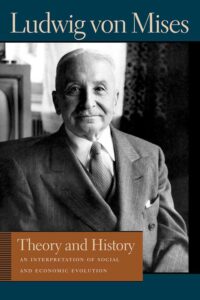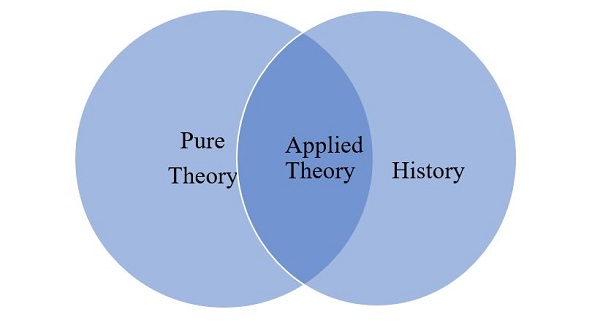Interpreting Social and Economic Evolution
By Rosolino Candela


- A Liberty Classics Book Review of Theory and History: An Interpretation of Social and Economic Evolution, by Ludwig von Mises. 1
According to Mises, the “history of mankind is the record of a progressive intensification of the division of labor” and among the greatest scientific achievements “of eighteenth-century social philosophy is the disclosure of the role which the principle of higher productivity resulting from division of labor has played in history” (1957 [2005], p. 156). The unifying substantive proposition of social order that social philosophers of the 18th century and political economists of the 19th century had discovered and developed was the science of invisible hand theorizing, in which private property and freedom of contract under the rule law were the governing institutional prerequisites for social cooperation without command. Understood this way, Mises’s task is twofold. First, before elaborating on the relationship between theory and history, Mises goes to great lengths and provides careful detail to distinguish economic theory from its scientific neighbors both in the natural sciences as well as other social scientists. Only then can Mises address other “sciences” that not only reject the universal validity of the science of human action across time and place, but also attempt to understand social and economic change without theory.
The nature of any science, whether natural or social, according to Mises, is to explain a sequence of historical events as being determined by a systematic chain of cause and effect. “History is entirely guided by the category of cause and effect” (1957 [2005] p. 62). Although the social sciences (or the “sciences of human action” as Mises refers to them) and the natural sciences have this common point of analytic departure, how such systematic generalizations of cause of effect are explained differs because of a methodological dualism between the social sciences and the natural sciences.
According to Mises, the “genuine history of mankind is the history of ideas. It is ideas that distinguish man from all other beings. Ideas engender social institutions, political changes, technological methods of production, and all that is called economic conditions. And in searching for their origin we inevitably come to a point at which all that can be asserted is that a man had an idea” (1957 [2005], p. 126). Because of the fact that ideas in human minds are the catalyst for social and economic events, but “we do not know how external events—physical, chemical, and physiological—affect human thoughts, ideas, and judgments of value” means that an unavoidable split between the natural sciences and the sciences of human action. If the effects of human action could be directly reduced to physiological causes, then human history could be reduced to the laws of the natural sciences, one that discovers patterns of human action in terms of passive response to stimuli. But, whereas as under “identical conditions stones always react to the same stimuli in the same way,” human beings “react to the same stimuli in different ways, and the same man at different instants of time may react in ways different from his previous or later conduct” (1957 [2005], p. 3).
Such a methodological dualism by no means implies a shortcoming of the sciences of the human action, as Mises argues (1957 [2005], p. 6). Thus, the sciences of human action share the same ontological status as the natural sciences in terms of discovering systematic generalizations of cause and effect that are valid across time and place, but how we come to know how such processes of cause and effect unfold across time and place differs in the sciences of human action. “Being himself a valuing and acting ego,” human beings know by introspection what it means to assign value to a set of means and act according to the purposive application of a set of means to achieve a particular end. “Thus, we are aware that he is not neutral with regard to the various states of his environment, that he prefers certain states to others, and that he consciously tries, provided the conditions for such interference on his part are given, to substitute a state that he likes better for one he likes less” (1957 [2005], p. 188). It is in this sense, Mises argues, that what historians refer to as “progress” or “civilization” results from human beings striving “to substitute more satisfactory conditions for less satisfactory ones. Ideas determine what are to be considered more and less satisfactory conditions and what means are to be resorted to to alter them. Thus ideas are the main theme of the study of history” (emphasis added; 1957 [2005], 150).
The adoption of methodological dualism has important implications regarding how outcomes are “determined” according to theory, the relationship between cause and effect, and therefore the how theory and history intersect with one another, in both the natural sciences and the sciences of human action. Mises provides a careful and subtle understanding of these implications not by rejecting the role of “determinism” in the social sciences, but by drawing a distinction between a “fatalistic determinism” and an “active determinism” (1957 [2005], p. 117). While indeed Mises refutes indeterminate “theories” to explain social and economic phenomena, such as those held by the German Historical School, which rejected the universal validity of economic laws across time and place (see Chapter 10), “the old antagonism of determinism and indeterminism is inappropriate” and “does not correctly describe the substance of the controversy” (1957 [2005], p. 61).
According to Mises, fatalistic determinism refers to a historical process driven by individuals passively responding to external stimuli, whereby social outcomes in history were driven directly by external forces independent of human volition. One example of such fatalistic determinism is the dialectical materialism of Marxism (see Chapter 7), in which “individual” goals are driven by class struggle and “the inexorability of a law of nature” in which “capitalistic production begets its own negation” that inevitably ushes in socialism (emphasis original; Mises 1957 [2005], pp. 95-96). Another example of such fatalistic determinism to which Mises refers is “scientism,” which refers to the inappropriate procedure of applying the methods of the natural sciences to the social sciences. To the extent that the science of human action is about ends being put into effect by the purposive application of means, this implies that the sciences of human action are not only about means, but meaning attached to purposive human action, scientism can generate. But if the purpose of science is primarily driven about predicting human outcomes in terms of behavioral constants, rather than understanding the pursuit of concrete human purposes, then economics is purged of its primary subject matter: meaning.
There is no doubt that economic laws, such as the quantity theory of money, can predict that over a period of time an increase in the money supply will result in a proportional increase in the price level. However, such a macroeconomic outcome cannot be understood without first understanding that “money” does not exist as an object without human beings first attaching meaning to a particular object with the expectation that it will be accepted as a commonly accepted medium of exchange, nor that what drives up the price level is that human beings are competing for relatively fewer goods with a relatively greater quantity of money. For Mises, to the extent that such doctrines can be called “theory,” they are best understood as theories of human inaction rather than human action, whereby human beings are passengers driven by external social, technological, or other material forces of history. Thus, if economic theory can predict, it does so by contributing to “the elucidation of future events; it can predict within the limits drawn to praxeological prediction” based on filtering the category of human action by understanding the historical circumstances of time and place within which an individual is acting (Mises 1957 [2005]: 136).
By active determinism, Mises refers to a historical process of cause and effect in terms of an indirect relationship between purposive human action and social outcomes. Such an indirect relationship means that social outcomes cannot be directedly reduced to the goals pursued by individuals. Nor can such goals themselves be reduced either to internal physiological, chemical, or physical processes in the human body or to passive responses to the context of an individual’s physical or ideological environment. As Mises writes, “ideas have a real existence and are genuine factors in shaping the course of events. The offshoots of human mental efforts, the ideas and the judgments of value that direct the individuals’ actions, cannot be traced back to their causes, and are in this sense ultimate data” (1957 [2005], p. 52). Thus, Mises is quite clear that the outcomes of history, though certainly based on human action, are not a product of rational human design:
-
- The conscious intentional actions of individuals, great and small, determine the course of events insofar as it is the result of the interaction of all men. But the historical process is not designed by individuals. It is the composite outcome of the intentional actions of all individuals. No man can plan history. All he can plan and try to put into effect is his own actions which, jointly with the actions of other men, constitute the historical process (emphasis added; Mises 1957 [2005], p. 131).
Both the quote above and the notion of active determinism, which undergirds the sciences of human action (i.e. praxeology)—including its most developed branch (as Mises refers to it), economics—implies that what Mises refers to as praxeology or “theory” must be understood as having two distinct parts: pure theory and applied theory, as illustrated in the Venn diagram in Figure 1.

Pure theory is the necessary core of praxeology, which is based on the category of direct cause and effect: human beings have goals and they deliberately choose the most effective set of means to achieve those goals. Such purposive human action is the origin of social phenomena such as money, prices, law, and other institutions, which originate from human action but are not of human design. This leads us to the second part of praxeology, applied theory, also known as “catallactics,” which is that portion of praxeology that deals specifically with social interaction between individuals. It is the realm of spontaneous-order analysis, from which the unintended emergence of money, prices, and institutions can be traced back to human action, but nevertheless based on human beings choosing productive specialization and exchange as the means by which to achieve their goals.
For more on these topics, see
 Peter Boettke on Mises. EconTalk.
Peter Boettke on Mises. EconTalk.- Human Action: A Treatise on Economics, by Ludwig von Mises. Econlib.
Though pure theory is necessary, its application to understanding history is contingent on various subsidiary assumptions of a particular time and place, such as private property, prices, and profit-and-loss signals, the economist can explain the various manifestations of rationality under alternative institutional contexts. Thus, for Mises, theory and history are inextricably intertwined and supported by what Mises refers to as “thymology,” a historical discipline that complements theoretical explanation by interpreting why human beings have chosen a particular set of ends, and perceived a particular set of means as appropriate for that end for that particular time and circumstance. “The outstanding fact about history is that it is a succession of events that nobody anticipated before they occurred” (Mises 1957 [2005], p. 250), but the social scientist, aided by theory not as reality itself, but as a tool for understanding reality, can render intelligible how social cooperation without command became possible in the past, and understand what are the institutional preconditions for its continuation in the future.
References
Ebeling, Richard M. (ed.). 2012. Selected Writings of Ludwig von Mises, Vol. 1: Monetary and Economic Policy Problems Before, During, and After the Great War. Indianapolis: Liberty Fund.
Ebeling, Richard M. (ed.). 2002. Selected Writings of Ludwig von Mises, Vol. 2: Between the Two World Wars: Monetary Disorder, Interventionism, Socialism, and the Great Depression. Indianapolis: Liberty Fund.
Ebeling, Richard M. (ed.). 2000. Selected Writings of Ludwig von Mises, Vol. 3: The Political Economy of International Reform and Reconstruction. Indianapolis: Liberty Fund.
Mises, Ludwig von. 1957 [2005]. Theory and History: An Interpretation of Social and Economic Evolution.
Footnotes
[1] Mises, Ludwig von. Theory and History: An Interpretation of Social and Economic Evolution. Liberty Fund, 1957 [2005]. Also available online at: Theory and History: An Interpretation of Social and Economic Evolution (LF ed.).
[2] Selected Writings of Ludwig von Mises. Liberty Fund Books.
